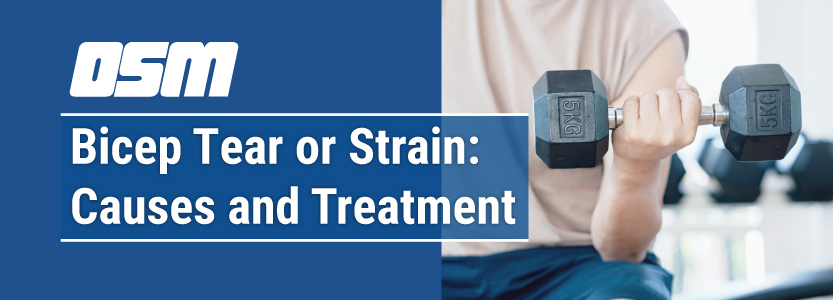Bicep Tear or Strain: Causes and Treatment
Article featured on MercyHealth
What is a bicep tear or strain?
A bicep tear is a strain or tear in the bicep muscle that can occur in the shoulder or elbow. The tear can be complete (the tendon has torn completely away from the bone) or partial.
Bicep tears or strains are classified as grades 1 – 3 depending upon severity of the injury.
Types of bicep tears or strains
- Grade 1 — minor injury that involves overstretching the biceps muscle or tendon, typically without a loss of strength or mobility.
- Grade 2 — causes moderate tearing in the biceps or tendon with some loss of mobility or strength.
- Grade 3 — a complete rupture of the biceps muscle or tendon, may require surgery to repair.
Causes of a bicep tear or strain
There are a variety of causes for a bicep tear or strain including:
- Constant overuse — sports that require repetitive movement on the bicep in the shoulder or elbow can cause a bicep tear or strain.
- Acute injury — moving or twisting your elbow in an unfamiliar way can cause a bicep tear or strain, for example, falling on an outstretched arm.
Risk factors for a bicep tear or strain
Individuals at risk for a bicep tear or strain include:
- People who participate in sports that require throwing, such as baseball or softball
- People with poor circulation
- People with previous shoulder or other upper-arm injuries
- People who don’t warm up for sporting activities as much as they should
Symptoms of bicep tear or strain
The most common symptom of a bicep tear or strain is a sudden burst of pain in the upper arm near the shoulder. You could also hear a “popping” sound as the tendon tears. Other signs that you may have torn a bicep tendon can include:
- Weakness in the shoulder
- Bruising on the upper arm
- Inability to move or rotate your arm
- Change in the look of the bicep in the upper arm (it may look popped out)
- Muscle spasms
Diagnosis of bicep tear or strain
Your doctor can diagnose a bicep tear or strain in a full physical exam. Your doctor will ascertain your symptoms and medical history before performing physical tests. In a complete tear, diagnosis is obvious due to the appearance of a bump on the upper arm.
Other shoulder conditions, such as rotator cuff injuries, shoulder impingement and shoulder tendinitis, often accompany a bicep tear.
Your doctor may order diagnostic tests, like an x-ray or MRI, to evaluate the severity of the injury and if you have any other conditions.
Treatment of bicep tear or strain
In most cases, nonsurgical treatments will relieve the symptoms associated with a torn or strained bicep. Nonsurgical treatment options include rest, ice and anti-inflammatory medications.
Other nonsurgical treatments may include:
- Physical therapy and rehabilitation — exercises to help improve shoulder flexibility and build shoulder strength, your physical therapist will develop a treatment plan that is customized for you.
- Platelet rich plasma (PRP) therapy — helps speed up the recovery process up by injecting concentrated growth factor platelets from your blood back into the affected shoulder. PRP therapy is a newer treatment option for soft tissue injuries.
It is rare for a patient to need surgical treatment for a bicep tear. Candidates for surgery include:
- People who experience chronic cramping or muscle pain in the bicep near the shoulder
- Athletes who need to have complete range of motion restored
- People who have occupations that demand full range of motion in the shoulder
There are several surgeries your surgeon could recommend to repair bicep tear including:
- Bicep tenodesis — bicep tenodesis surgery will anchor the ruptured end of the biceps tendon to the bone with a screw.
- Acromioplasty and direct tenodesis — this is a procedure that is more commonly performed on younger patients who have a history of prior shoulder injuries.
Recovery from bicep tear or strain
The time needed to recover from a bicep tear or strain will depend on many factors, including age and health of patient, as well as severity of the injury. Mild injuries take ten weeks or more, while more severe injuries that require surgery can take months to fully recover function.
Your physical therapist and orthopedic surgeon will require you to wear a sling for four weeks following surgery and gradually build up your strengthening exercises as you get stronger. Physical therapy will be crucial to strengthening the muscles to allow you to return to your day-to-day activities.
During the recovery process, avoid participating in activities that cause pain (other than physical therapy).
The Orthopedic & Sports Medicine Center of Oregon is an award-winning, board-certified orthopedic group located in downtown Portland Oregon. We utilize both surgical and nonsurgical means to treat musculoskeletal trauma, spine diseases, sports injuries, degenerative diseases, infections, tumors and congenital disorders.
Our mission is to return our patients back to pain-free mobility and full strength as quickly and painlessly as possible using both surgical and non-surgical orthopedic procedures.
Our expert physicians provide leading-edge, comprehensive care in the diagnosis and treatment of orthopedic conditions, including total joint replacement and sports medicine. We apply the latest state-of-the-art techniques in order to return our patients to their active lifestyle.
If you’re looking for compassionate, expert orthopedic surgeons in Portland Oregon, contact OSM today.
Phone:
503-224-8399
Address
17355 Lower Boones Ferry Rd Suite 100A
Lake Oswego, OR 97035
Hours
Monday–Friday
8:00am – 4:30pm



